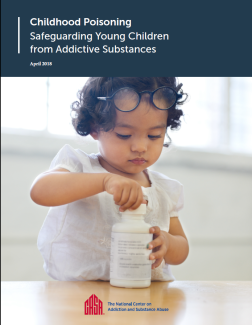Childhood Poisoning: Safeguarding Young Children from Addictive Substances

BACKGROUND
As a result of America’s current addiction epidemic, babies and pre-school age children are being accidentally exposed at unacceptably high rates to toxic, addictive substances including nicotine, alcohol, caffeine, prescription drugs, marijuana and illicit drugs. Fortunately, there are steps parents, health care professionals, policymakers, industry and researchers can take to prevent such occurrences and protect children from the potentially life-threatening effects of these substances.
METHODS
This report summarizes the available research on the nature, extent, and consequences of young children’s exposure to a range of addictive substances based on data collected by the American Association of Poison Control Centers (AAPCC), as well as other research reports and data sources. It explains why and how such exposures occur, and what the barriers are to preventing them. Finally, it provides a comprehensive approach to addressing the problem of childhood exposures and poisonings.
RESULTS
In 2016 alone, there were more than 30,500 reports to poison control centers of young children exposed to addictive substances. The number of children aged five and younger who have been exposed to the toxic effects of nicotine, alcohol, caffeine, marijuana, certain opioids and methamphetamine have increased over the past decade, as have the number of children who experience serious consequences from these events. Additional key findings include:
- Exposures to marijuana increased by 148 percent over a seven-year period.
- Exposures to prescription opioid pain relievers increased 93 percent each year over a nine-year period, corresponding to the opioid epidemic’s progression.
- Calls to poison control centers about e-cigarettes increased more than 1,400 percent in just three years.
- The number of young children exposed to alcoholic beverages has increased every year since 2012.
RECOMMENDATIONS AND CONCLUSIONS
This report offers concrete recommendations for parents and other caregivers, health care professionals, policymakers, industry and researchers to ensure that the growing availability of addictive products is met with an effective response that will protect the youngest victims of substance use and addiction.